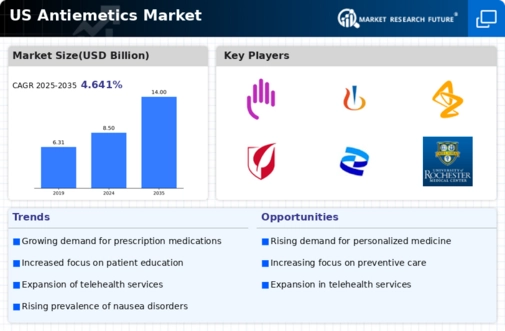Advancements in Drug Formulations
Innovations in drug formulations are playing a crucial role in shaping the antiemetics market. The development of long-acting formulations and combination therapies is enhancing the efficacy and convenience of antiemetic treatments. For instance, the introduction of transdermal patches and orally disintegrating tablets is providing patients with more options for managing nausea. These advancements are likely to improve patient adherence to treatment regimens, which is essential for effective nausea management. As pharmaceutical companies continue to invest in research and development, the antiemetics market is expected to benefit from a wider array of innovative products that cater to diverse patient preferences and needs.
Increasing Healthcare Expenditure
The rising healthcare expenditure in the US is a significant driver for the antiemetics market. As healthcare spending continues to grow, there is a corresponding increase in the availability of advanced medical treatments, including antiemetic therapies. In 2025, healthcare expenditure in the US is projected to reach approximately $4 trillion, reflecting a commitment to improving patient care. This financial investment is likely to facilitate the development and accessibility of antiemetic medications, ensuring that patients have access to effective treatments for nausea. Furthermore, increased healthcare spending may lead to greater insurance coverage for antiemetic therapies, further driving market growth as more patients seek and receive treatment.
Rising Awareness of Nausea Management
There is a notable increase in awareness regarding the importance of nausea management among both healthcare professionals and patients, which is influencing the antiemetics market. Educational initiatives and campaigns aimed at highlighting the impact of nausea on quality of life are gaining traction. This heightened awareness is likely to lead to more patients seeking treatment for nausea-related conditions, thereby driving demand for antiemetic medications. In the US, healthcare providers are increasingly recognizing the need for effective nausea management strategies, which may result in a shift towards prescribing antiemetics more frequently. Consequently, this trend could contribute to the overall growth of the antiemetics market as more individuals are treated for nausea.
Regulatory Support for Antiemetic Innovations
Regulatory bodies in the US are increasingly supportive of the development and approval of new antiemetic therapies, which serves as a significant driver for the antiemetics market. The FDA has streamlined the approval process for novel antiemetic drugs, particularly those targeting specific patient populations, such as cancer patients. This regulatory environment encourages pharmaceutical companies to invest in research and development, leading to a broader range of treatment options. As a result, the market is likely to witness an influx of innovative antiemetic products, catering to diverse patient needs. The potential for expedited approvals and favorable regulatory pathways may further stimulate market growth, as companies aim to capitalize on emerging opportunities.
Growing Incidence of Nausea-Related Conditions
The rising prevalence of nausea-related conditions, such as motion sickness, chemotherapy-induced nausea, and postoperative nausea, is a key driver for the antiemetics market. In the US, it is estimated that approximately 30% of patients undergoing chemotherapy experience severe nausea, necessitating effective antiemetic therapies. This growing patient population is likely to increase the demand for antiemetic medications, thereby propelling market growth. Furthermore, the increasing awareness of nausea management among healthcare providers and patients contributes to the expansion of the antiemetics market. As more individuals seek treatment options, pharmaceutical companies are incentivized to innovate and develop new antiemetic drugs, enhancing the overall market landscape.

















Leave a Comment